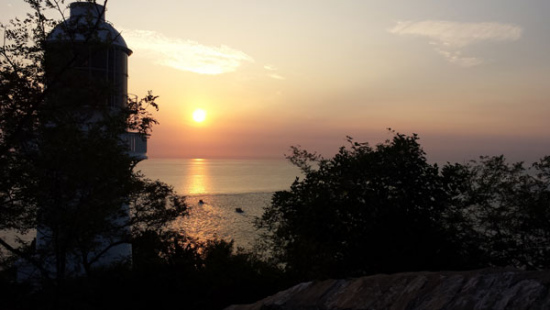Simple delights by the sea
 0 Comment(s)
0 Comment(s) Print
Print E-mail China Daily, May 5, 2015
E-mail China Daily, May 5, 2015
|
Sunset, seen from the lighthouse on Laotie Hill on the outskirts of Lyushun, Liaoning province, tinges the boundary between the Bohai Sea and the Yellow Sea. (Photo by Chen Liang/China Daily) |
Because Lyushun is actually a district of Dalian, the major gateway to Northeast China, it is easy to arrange a weekend trip to the area from not only Beijing, but also major cities along the coast of the Bohai Sea, by air, train or even passenger liners. Surrounded by the Bohai Sea on three sides, Lyushun's geographical importance has historically led the area to be dogged by misfortune.
In 1894, during the War of Jiawu, also known as the first Sino-Japanese War, between Aug 1, 1894 and April 17, 1895, the Japanese army captured Lyushun and massacred many of its people. Lyushun suffered again in 1904 when it became a major battlefield during the Russo-Japanese War (Feb 8, 1904-Sept 5, 1905). It then endured Japanese rule for more than 40 years until 1945.
The only benefit from these difficult years are a number of historical sites, many of which feature Japanese and Russian-style buildings, that can be seen in the seaside resort also known as Port Arthur. They have become major tourist attractions of Lyushun.
The Russo-Japanese War Site on Jiguan Hill (or East Crest Hill) was a battlefield during the Russo-Japanese War. It was there that the Russian army established a strong fortress-North Bastion, after Lyushun became a territory leased to Russia in 1898.
The bastion covers an area of nearly 10,000 square meters and is 496 meters in circumference. Winding entrenchments, back channels, bunkers, ammunitions, barracks and a command post remain at the site. Replicas of Russian cannons can be seen in the woods. A museum was built in 1997 to display historical materials of the war, but it is not interesting enough for a closer look.
Originally built in 1917, the Lyushun Museum is housed in an elegant European style building and spread across 25,000 square meters. Over 60,000 exhibits are displayed in 20 sections, including Japanese paintings, ancient ceramics, bronze wares and relics from the Xinjiang Uygur autonomous region. One of the best museums in Northeast China, it is worth a half-day visit. The museum grounds are also famous for their flowering cherry trees in the early spring.







